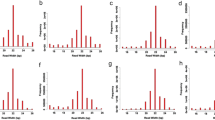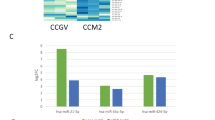Abstract
Micro RNAs (miRNA) are integral components of genetic regulatory networks and act by binding to the transcripts of their corresponding target genes, leading to a decrease in protein production levels either by mRNA degradation or by translational repression. While the role of miRNAs is ubiquitous, they have a particular importance with regard to cell differentiation. The miRNA-target mRNA interaction has a significant impact on many signaling pathways and the cross-talk between them; playing a regulatory role in a variety of different physiological processes within the cells. Ovarian follicle development is a physiological process that is not fully understood with regard to miRNA regulation; there are many questions that remain with respect to the molecular regulation of this important process. Bovine follicular cells are a good experimental model for the investigation of these mechanisms, having direct implications on reproductive health in humans. This chapter describes how differentially expressed miRNAs are identified in the granulosa and theca cells of dominant and subordinate bovine ovarian follicles and the identification of their associated targets and pathways. This chapter systematically describes how the granulosa and theca cells are dissected from the ovarian follicles. Afterward, we present a detailed protocol for miRNA extraction, based on a combined TRI reagent/column clean-up method, and also miRNA expression profiling using both microarray and RT-qPCR. In addition, an outline is provided of the bioinformatic analysis which enables the prediction of miRNAs targets. Pathways associated with the differentially expressed miRNAs are also elucidated using DIANA-miRPath software.
Access this chapter
Tax calculation will be finalised at checkout
Purchases are for personal use only
Similar content being viewed by others
References
Berry DP, Wall E, Pryce JE (2014) Genetics and genomics of reproductive performance in dairy and beef cattle. Animal 8:105–121
Baerwald AR, Adams GP, Pierson RA (2003) Characterization of ovarian follicular wave dynamics in women. Biol Reprod 69:1023–1031
Evans AC (2003) Characteristics of ovarian follicle development in domestic animals. Reprod Domest Anim 38:240–246
Evans AC, Ireland JL, Winn ME, Lonergan P, Smith GW, Coussens PM, Ireland JJ (2004) Identification of genes involved in apoptosis and dominant follicle development during follicular waves in cattle. Biol Reprod 70:1475–1484
Mihm M, Baker PJ, Ireland JL, Smith GW, Coussens PM, Evans AC, Ireland JJ (2006) Molecular evidence that growth of dominant follicles involves a reduction in follicle-stimulating hormone dependence and an increase in luteinizing hormone dependence in cattle. Biol Reprod 74:1051–1059
Zielak AE, Forde N, Park SD, Doohan F, Coussens PM, Smith GW, Ireland JJ, Lonergan P, Evans AC (2007) Identification of novel genes associated with dominant follicle development in cattle. Reprod Fertil Dev 19:967–975
Forde N, Mihm M, Canty MJ, Zielak AE, Baker PJ, Park S, Lonergan P, Smith GW, Coussens PM, Ireland JJ, Evans ACO (2008) Differential expression of signal transduction factors in ovarian follicle development: a functional role for betaglycan and FIBP in granulosa cells in cattle. Physiol Genomics 33:193–204
Walsh SW, Mehta JP, McGettigan PA, Browne JA, Forde N, Alibrahim RM, Mulligan FJ, Loftus B, Crowe MA, Matthews D, Diskin M, Mihm M, Evans AC (2012) Effect of the metabolic environment at key stages of follicle development in cattle: focus on steroid biosynthesis. Physiol Genomics 44:504–517
Kozomara A, Griffiths-Jones S (2014) miRBase: annotating high confidence microRNAs using deep sequencing data. Nucleic Acids Res 42(DI):D68–D73. https://doi.org/10.1093/nar/gkt1181
Dedeoğlu BG (2014) High-throughput approaches for microRNA expression analysis. In: miRNomics: microRNA biology and computational analysis, vol 1107. Springer, Berlin, pp 91–103
Zielak-Steciwko AE, Browne JA, McGettigan PA, Gajewska M, Dziecioł M, Szulc T, Evans ACO (2014) Expression of microRNAs and their target genes and pathways associated with ovarian follicle development in cattle. Physiol Genomics 46:735–745
Pritchard CC, Cheng HH, Tewari M (2012) MicroRNA profiling: approaches and considerations. Nat Rev Genet 13:358–369
Tam S, de Borja R, Tsao M, McPherson JD (2014) Robust global microRNA expression profiling using next-generation sequencing technologies. Lab Investig 94:350–358
Peterson SM, Thompson JA, Ufkin ML, Sathyanarayana P, Liaw L, Congdon CB (2014) Common features of microRNA target prediction tools. Front Genet 5:1–10
John B, Enright AJ, Aravin A, Tuschl T, Sander C, Marks DS (2004) Human MicroRNA targets. PLoS Biol 2:e363
Lewis BP, Burge CB, Bartel DP (2005) Conserved seed pairing, often flanked by adenosines, indicates that thousands of human genes are microRNA targets. Cell 120:15–20
Maragkakis M, Reczko M, Simossis VA, Alexiou P, Papadopoulos GL, Dalamagas T et al (2009) DIANA-microT web server: elucidating microRNA functions through target prediction. Nucleic Acids Res 37:W273–W276
Vlachos IS, Zagganas K, Paraskevopoulou MD, Georgakilas G, Karagkouni D, Vergoulis T, Dalamagas T, Hatzigeorgiou AG (2015) DIANA-miRPath v3.0: deciphering microRNA function with experimental support. Nucleic Acids Res 43:W460–W466. https://doi.org/10.1093/nar/gkv403
Chomczynski P, Mackey K (1995) Substitution of chloroform by bromo-chloropropane in the single-step method of RNA isolation. Anal Biochem 225:163–164
Author information
Authors and Affiliations
Corresponding author
Editor information
Editors and Affiliations
Rights and permissions
Copyright information
© 2018 Springer Science+Business Media, LLC
About this protocol
Cite this protocol
Zielak-Steciwko, A.E., Browne, J.A. (2018). How to Explore the Function and Importance of MicroRNAs: MicroRNAs Expression Profile and Their Target/Pathway Prediction in Bovine Ovarian Cells. In: Ying, SY. (eds) MicroRNA Protocols . Methods in Molecular Biology, vol 1733. Humana Press, New York, NY. https://doi.org/10.1007/978-1-4939-7601-0_8
Download citation
DOI: https://doi.org/10.1007/978-1-4939-7601-0_8
Published:
Publisher Name: Humana Press, New York, NY
Print ISBN: 978-1-4939-7600-3
Online ISBN: 978-1-4939-7601-0
eBook Packages: Springer Protocols




